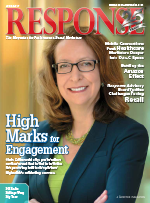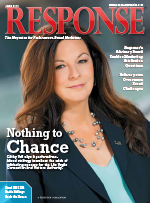 Here’s hoping everyone had a great 4th of July holiday! After returning from a week in Massachusetts, visiting my wife’s family and friends, I pushed through my inbox and some other pressing matter to give myself a few moments to put together a quick recap of Response‘s June issue. While we’re still getting back on track with timing following late April’s Response Expo, the issue has been online and hitting mailboxes for more than 2 weeks now. Led by a cover story on one of Blue Cross Blue Shield‘s largest affiliates, Highmark, the issue also includes features on the wider healthcare and pharmaceuticals market and a pair of loosely connected stories: a roundtable on the vast effects of Amazon on marketers and retailers of all stripes; and our second quarterly Advisors Forum of 2017, which tackles the rapidly changing retail space. Looking for background on how these items — and more — came together? You’ve come to the right place.
Here’s hoping everyone had a great 4th of July holiday! After returning from a week in Massachusetts, visiting my wife’s family and friends, I pushed through my inbox and some other pressing matter to give myself a few moments to put together a quick recap of Response‘s June issue. While we’re still getting back on track with timing following late April’s Response Expo, the issue has been online and hitting mailboxes for more than 2 weeks now. Led by a cover story on one of Blue Cross Blue Shield‘s largest affiliates, Highmark, the issue also includes features on the wider healthcare and pharmaceuticals market and a pair of loosely connected stories: a roundtable on the vast effects of Amazon on marketers and retailers of all stripes; and our second quarterly Advisors Forum of 2017, which tackles the rapidly changing retail space. Looking for background on how these items — and more — came together? You’ve come to the right place.
- The cover feature on Pittsburgh-based Highmark — featuring an interview with Chris Zdanowski, director, strategic marketing, senior markets, commercial markets, and retail — had its beginnings in an email pitch from Highmark’s agency, Partners + Napier, in February. Shortly thereafter, I connected with Becca Bellush, the agency’s associate director of PR and social media, who served as an outstanding liaison between the Highmark team and me. Not only was this story a pleasure to work on from start to finish, due to the accessibility of Bellush, Zdanowski, and all others involved, but it also bore out many of the concepts we’ve been talking about recently in Response. The highlighted campaign features a mix of online and offline media, has a clear and measurable goal, and maximizes back-end technology to track results. If you missed the link to the story above, here it is once again: Marketing With High Marks
- Beyond Highmark’s success using performance-based marketing tactics, our freelancer Bridget McCrea tackled a wider look at what’s new in marketing across the healthcare and pharmaceutical markets. She found marketers, both large and small, utilizing new technology to take their messages — and more importantly, their services — directly to consumers, at the time and place they wish. From using secure, online video chat to apps that allow patients to make more informed decisions about their care, health and pharma marketers are ahead of the technological game. In case you skipped the link above: The Future of Healthcare Has Arrived — and It’s D-to-C
- Riffing from one of our most popular sessions at Response Expo, a third feature — penned by freelancer Doug McPherson — takes a look at the many ways Amazon is changing business, from the top of the sales funnel to the bottom. We enlisted three of the speakers from that “Amazon Effect” Expo session — Jaffer Ali of PulseTV.com, Matt Fiedler of Vinyl Me, Please, and Rus Sarnoff of Integrated Marketing — to give us an overview of a few of those issues. Here’s that story link again: It’s a Jungle Out There
- The second of our quarterly roundtables featuring members of the Response Advisory Board takes a look at the changing face of retail. Early in May, I sent a series of questions to our advisors and five leaders stepped up to share their thoughts on how brick-and-mortar and e-commerce can not only coexist but flourish as consumer desires — and their attendant habits — change. If you missed the link, it’s right here: The Changing Face of Retail
- Our monthly direct response TV and radio media billings return to the DR radio sector for fourth-quarter 2016 results. The radio market notched a fifth consecutive quarterly increase — this time, 6.7 percent. However, the big news is that 2016’s total of $69.9 million marked the radio market’s best year since 2004. How did it happen? For a full look at 4Q 2016 DR radio media billings, click here: DR Radio Billings Continue Winning Streak to Close 2016
- Other key items in this month’s issue include:
- A Support Services column from Ship-Right Solutions‘ Craig Lennon discussing the importance of order management systems to delivering the best customer experience.
- A Web Exclusive column from Response Advisory Board member Peter Koeppel of Koeppel Direct that discusses the many threats — and opportunities — presented by current TV marketing trends.
- Additional columns from Omni Direct’s Denira Borrero and Thane Direct’s Anthony Booth.
- My Editor’s Note column riffs off of an idea I’ve formulated recently while attending industry events and thumbing through other publications. And it closes with a concept you’re going to see an awful lot of in the coming months — more pointedly than ever before. If you’ve been inattentive to the direction Response has taken and if you missed the link above, here it is: The Third Leg — Media Drives Technology and Commerce
Thanks again for reading and interacting with Response!

